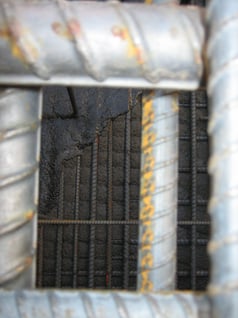Concrete is a mixture of aggregate, Portland cement, and water. But what actually holds concrete together? The answer is the hydrated cement matrix – the glue of concrete. Concrete is formed when Portland cement materials are combined with water to create a paste that binds with sand and rock to harden and form a composite structure. Common materials used to manufacture cement include limestone, shells, and chalk or marl combined with shale, clay, slate, blast furnace slag, silica sand, and iron ore. These ingredients, when heated at high temperatures, form a rock-like substance that is ground into the fine powder we call cement.
The hardened cement matrix of the concrete composite is a porous and hardened sponge that provides the structural strength for civil construction as well as the backbone for durability and a long service-life.
The ultimate object of combining Portland cement with supplementary cementitious material is to increase the efficiency of the cementitious matrix, maintain and enhance the fresh and hardened properties.
Why do we care?
Concrete is one of the oldest and most reliable construction materials in the world. Concrete is at the foundation of our civilizations providing everything from the sidewalks in urban, suburban, and rural areas; to the enormous concrete dams, like the Hoover Dam, spillways, and locks.
In order to achieve the durability of concrete, large amounts of Portland cement are utilized. Although cement provides concrete binding, cement production accounts for 3-5% of the worlds CO2 emission.
Cement is manufactured through a closely controlled chemical combination of calcium, silicon, aluminum, iron and other ingredients. The manufacturing of cement is a long process and at every stage of its production, the environment is affected. Carbon emissions, water pollution, and release of heavy metals in the air are common problems associated with manufacturing.
Cement dust is a pollutant that affects both the health of people and plants. Chronic diseases and respiratory disorders are observed in people who work in a cement industry and are exposed to the cement constituents and cement dust. The setting of cement is a long process and it is alkaline in nature, which may lead to lung and skin disorders because of the excessive heat normally released during setting and curing (Cement Production, Hazards, and Recycling, 2011).
How does Juno XP affect the glue of concrete?
The proprietary and novel make-up of Juno XP effectively manipulates the molecular kinetics of cement hydration to increase the toughness and durability of concrete; making concrete stronger and last longer. The science behind Juno XP is a combination of pozzolanic and mineral materials that increase production of the strength-bearing microstructure. Juno XP also has a mechanical impact on fresh concrete and creates an environment that allows for a reduction of traditional cementitious material while maintaining the creaminess needed to allow grey concrete to go down the chute into the formwork.
Juno XP acts as a binder replacement to allows for a reduced the need for cement. Juno XP allows for the following:
- Maintenance of fresh properties
- Increase in Strength and Toughness of Hardened Concrete
- Environment for Portland Cement reduction is created
Juno XP creates performance based concrete that delivers the same properties of traditional concrete with a reduction in both cost and environmental impacts. Juno XP, saving the world with all the concrete in it.

